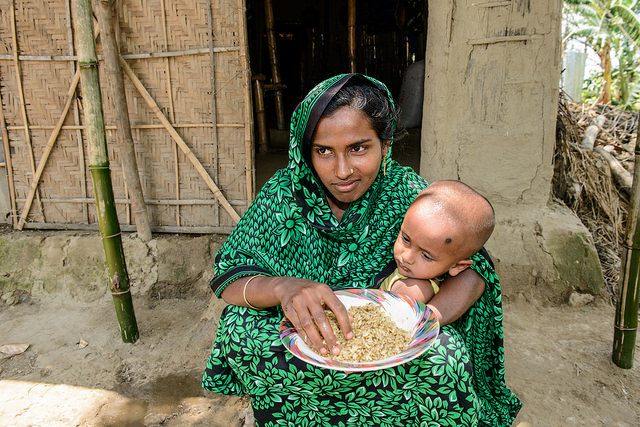Good nutrition in the earliest stages of life directly influences children’s future nutrition and development as they grow into healthy adults. Research has contributed to a set of guiding principles on the best infant and young child complementary feeding (IYCF) practices to promote healthy child growth, development, and nutrition.Yet good guidelines can only take us so far. Marie Ruel, Director of IFPRI’s Poverty, Health, and Nutrition Division and A4NH’s flagship lead on integrated nutrition programs and policies, comments:
The publication of the WHO infant and young child feeding (IYCF) indicators in 2008 equipped the nutrition and broader development community with an invaluable tool for measuring, documenting, and advocating for faster progress in improving these practices in low- and middle-income countries. The indicators, with five of them focusing on complementary feeding (CF) practices, were originally designed for population-level assessment, targeting, monitoring, and evaluation.
So far, the indicators have been used extensively for population-level assessments, country comparisons, and to track progress. They also have been adopted by researchers for impact evaluations of programs aimed at improving CF practices, and in research seeking to understand the determinants and consequences of poor CF practices for child growth and development outcomes. By helping generate knowledge and unveiling the severity of the global problem of poor CF practices, the indicators have been an invaluable tool for raising awareness and for calling for urgent action to improve CF practices at scale.
The indicators have several strengths. They are simple and practical, and therefore suitable for use in large national surveys. They also measure four key dimensions of CF practices (timing of introduction of complementary foods, dietary diversity, meal frequency, and intake of iron-rich foods).
On the other hand, the indicators also have limitations, including the following:
- Lack of validation against gold standard: With the exception of the minimum dietary diversity indicator, none of the indicators has been properly validated against a gold standard
- Subject to recall error and bias: The indicators rely on maternal recall of child feeding in the previous 24 hours; this can result in recall error (due to memory failure), or recall bias (mothers respond based on what they know to be the desired answers, rather than their practices). The latter error can be particularly pronounced if mothers have been exposed to interventions aimed at improving CF practices
- Subject to other measurement errors and misclassification related to the lack of quantitative information on food intake, the misclassification of meals and snacks, or the reporting of very small (nutritionally negligible) amounts of food consumed;
- Measure CF practices in the previous 24 hours and therefore fail to capture usual or long-term practices, and the dynamic process of CF practices
- Focus on preventing and reducing child undernutrition and do not include indicators for the prevention of childhood overweight and obesity.
The CF indicators were originally designed to serve as rough proxies for a few selected CF behaviors that are amenable to being measured in large-scale data collection exercises and they did very well for these purposes. They were not designed to reflect the intricacies and complexities of the multiple dimensions of CF practices, or to describe usual practices at different ages. However, given the interest and demand for more performant indicators, it is now time to revisit how we can improve and enhance our set of indicators.
Here are some suggestions for a way forward:
- Revisit the existing set of indicators and carry out relevant validation studies
- Develop simple ways to verify key assumptions underlying the indicators and adjust data collection procedures accordingly (e.g. energy density of the diet, which determines minimum number of meals needed to meet energy needs from complementary foods)
- Assess the levels of recall errors and biases related to the use of 24-hour recall methods and design ways to reduce them
- Develop indicators for additional key dimensions of CF practices such as responsive feeding, feeding during and after illnesses, safety in preparation and storage of complementary foods
- Develop a simplified, technology-smart 24-hour dietary assessment method to quantitatively measure nutrient intake in young children
- Develop and validate new indicators focused on the prevention of childhood overweight and obesity.
Enormous progress has been achieved since the WHO CF indicators were released in 2008. In the eight years of their existence, the application of the indicators has made tremendous contributions to enhancing awareness and knowledge about the status of CF practices nationally and globally. This has stimulated unprecedented interest and commitment among nutritionists and the wider development community to renew efforts to tackle the neglected area of CF as one of the critical inputs to accelerate progress in improving child nutrition. Yet more work remains to be done, and now is an opportune time to reflect and revisit existing CF indicators, improve upon them, develop new ones, and promote their appropriate use. Better indicators are critically important to stimulate action and investments in improving CF practices at scale.
This post is adapted from a presentation at a session at the 87th Nestle Nutrition Workshop in Singapore May 9-11 2016. The presentation is available on the A4NH SlideShare page.







